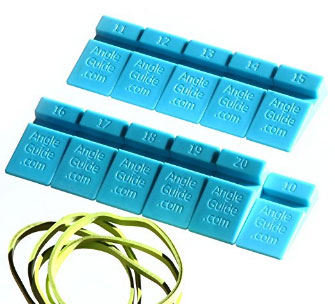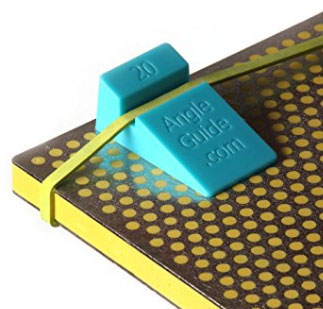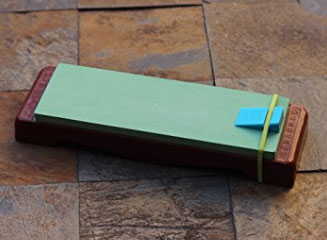Freehand how do they do it, how sharp do they get it?
Recent › Forums › Main Forum › Techniques and Sharpening Strategies › Freehand how do they do it, how sharp do they get it?
- This topic has 8 replies, 5 voices, and was last updated 04/04/2017 at 1:46 am by
Mark76.
-
AuthorPosts
-
03/31/2017 at 11:36 pm #38068
Just how hard is it to sharpen a knife freehand? and…. how do the best freehand jobs compare to those that use a jig or the wicked edge? ? ?
04/02/2017 at 2:57 am #38082This is an excellent question. I’m a freehand sharpener most of the time, but I am also quite well versed in using the good guided systems such as the WEPS.
The bottom line is this. A quality guided system will almost always kick a freehand edge’s butt. I don’t care who you are. I say almost always because there are always going to be factors such as technique and skill – which are pretty major factors – on both sides of the competition.
The first factor example is one of self competition, which is always the best way to do this since everyone is on their own sharpening journeys. Assuming you are equally proficient at both the WEPS and freehand, the WEPS will usually win out – but it in the spirit of self competition, I find myself saying “there’s no way I’m going to let the WEPS beat my freehand edge!” and I get to work on perfecting the next freehand edge I do, which then leaves me saying “there’s no way I’m going to let my freehand edge beat a precision edge off the WEPS!”, and so on. It pushes both of my skills, because ultimately they are different, and to call myself a sharpener requires me to be an expert on anything I sharpen with. (Self competition here)
The second example is you vs. me. This comes down to technique and skill. Technique trumps refinement 99% of the time, If we go head to head on the WEPS, we are equally equipped, and even if we use the same knives, angles and stones, I guarantee you we will have different results, which will vary depending on the differences between our skills and techniques. Same with freehand. When you compete between the guided and freehand, the same differences will determine the outcome. I once compared my freehand skills with a dealer for the WEPS in a shared market. Long story shorter, we were good friends before he found and fell in love with the WEPS after many years of not being able to get the freehand results he wanted. I actually had more experience on the WEPS than him at the time, and we did a friendly side by side – My Jende Reed Knives with him on the WEPS using Choseras and Shaptons, against me freehanding a 3rd knife. I fully expected my knife to come in a very distant third place, but my freehand knife came in at a solid second place. (like I said, almost always better on guided systems!) With a little tweaking here and there, we were able to get my knife in third place by the end of the visit. 🙂
Then there is the actual differences that most people don’t take into account, which the precision of the guided systems brings that freehand just can’t match. When most people compare freehand vs. guided, they do so at the same angles, which usually gives freehand the win for longevity, ironically. But it is not entirely true – the precision and accuracy of the WEPS allows you to be within 0.1 degree, which means the apex of the edge’s triangle is closer to a point of zero than that of a rather sloppy minimum 5 degree +/- of freehand, which essentially convexes the edge of the edge. So what would be an 18.0 (+/- 0.1) degree edge off the WEPS, would more than likely be a 23 degree edge freehand. so this whole 10-12 degree laser talk of freehand guys is really more like 15-20 on the WEPS….
The only real arguments that one can say makes one better than the other is the overall time investment, which coincides with the level of precision you require. Setting up the WEPS and calibrating it along the way can take some time per knife. Freehand sharpening is fast and makes on the fly, close enough for my house, adjustments. 🙂
3 users thanked author for this post.
04/02/2017 at 5:14 am #38083I agree with Toms comments above. Sharpening is like a “Zen- journey not a destination” kind of thing. I struggle to freehand and just prefer guided sharpening. I can do it and really think everyone needs to give it a go at least once. That is what makes the WE and other systems like it so amazing. The learning curve has been flattened forever. Someone with no skill at all can pick it up and get a premium working edge very quickly. Once the investment in time, money, and practice is made, the owner of these systems is set for life.

Eddie Kinlen
M1rror Edge Sharpening Service, LLC
+1(682)777-16221 user thanked author for this post.
04/02/2017 at 4:50 pm #38089minimum 5 degree +/- of freehand
I would say +/- 0.5 degrees. You can use angle guide reference point like those at AngleGuide.com. Human muscle memory is actually very good if you use reference point.
Attachments:
You must be logged in to access attached files.
2 users thanked author for this post.
04/03/2017 at 3:00 am #38100I agree, cool product.!

Eddie Kinlen
M1rror Edge Sharpening Service, LLC
+1(682)777-162204/03/2017 at 11:55 am #38118I just wondered how they do it in “Japan”. I purchased some of these $350 a piece japankitchenknives.com knives, and they are sharp in my opinion. They said if I send then in, for $30 every few months they send a box over to Japan to sharpen. This is what sent me down this crazy path of sharpening, because Im almost certain, if i took these knives locally to get sharpened, they would destroy them. As with many things nowadays, if you want it done right, you have to do it yourself. Any bosses here agree?
 04/03/2017 at 6:59 pm #38126
04/03/2017 at 6:59 pm #38126minimum 5 degree +/- of freehand
I would say +/- 0.5 degrees. You can use angle guide reference point like those at AngleGuide.com. Human muscle memory is actually very good if you use reference point.
I agree that muscle memory is very reliable, once learned. But, technically, that’s a guided sharpening system you’ve got pictured there… 🙂 That would be a very good learning tool for freehand sharpening, but if you take away the guide and sharpen from muscle memory without a reference point, I’m 100% positive you will get more than +/- 0.5 degrees in variation.
04/03/2017 at 8:01 pm #38127I just wondered how they do it in “Japan”. I purchased some of these $350 a piece japankitchenknives.com knives, and they are sharp in my opinion. They said if I send then in, for $30 every few months they send a box over to Japan to sharpen. This is what sent me down this crazy path of sharpening, because Im almost certain, if i took these knives locally to get sharpened, they would destroy them. As with many things nowadays, if you want it done right, you have to do it yourself. Any bosses here agree?

Sharpening in Japan is a trade skill, most often learned through apprenticing from a master. It’s the only place in the world where it is appreciated as its own art form. We all know the historic roots in Samurai sword polishing…
In Japan, knife making shops will often use a large, water cooled grinding stone wheel, basically a Tormek with a 1 meter diameter to grind and shape the edges and bevels. They then finish on stones. Aside from technique, the knives are kept cool at all times.
In the US, you get high speed grinding wheels with 6″ or 8″ diameters, and no water cooling. Belt grinders are better, especially variable speed ones, but you’d be surprised how quickly heat can build up on the edge of the edge just through friction, even at low speeds. Tormeks are good, but too small and slow to be as effective as the big wheels since one turn of the Japanese wheel gets you approx. 3.14 meters (more than 9 feet) of cutting power vs. the 18-25 inches (1.5-2 feet) on the grinding wheel or Tormek. Belts get you, depending on your grinder, anywhere from 36″ to 72″ (3-6 feet). Heat dissipation is key.
Back in the day, there used to be more skilled sharpeners in the US. There were a lot more woodworkers, barbers, butchers and tailors that usually maintained their own edges, but would still need to send the knife or tool out for maintenance every now and then. Hardware stores would usually have services as well as street grinders who would use 12-24″ hand cranked wheels sitting in a water trough. Sadly, just about all of that has gone away, and the “professional” sharpeners of today are largely scissor guys, and while there are certification courses and training available, there are some hacks out there…
I may have gone off on a tangent… 😀 I do agree that sharpening knives yourself is waaaaay more satisfying than sending it out to the great unknown. There’s the zen and meditative side of it all, plus the self challenge of being able to do something and to do it well while being self-sufficient.
3 users thanked author for this post.
04/04/2017 at 1:46 am #38130Yeah, nice product. So simple I’m thinking how come no one has ever come up with it before?Molecule Polishing: my blog about sharpening with the Wicked Edge
-
AuthorPosts
- You must be logged in to reply to this topic.




